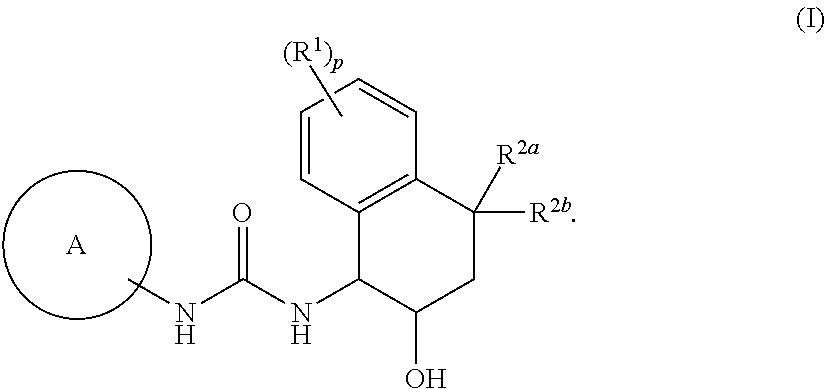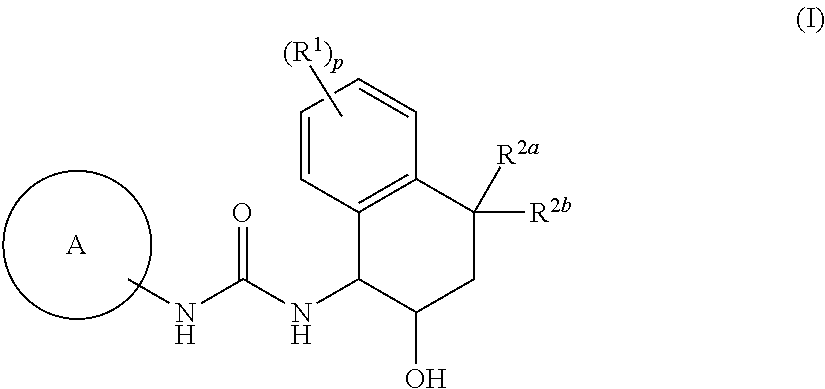Tetrahydronaphthyl urea derivative
a technology of tetrahydronaphthyl urea and urea derivative, which is applied in the field of compounds, can solve the problems of inability to tolerate oral administration, etc., and achieves excellent oral absorption, inhibitory action, and good pharmacokinetics.
- Summary
- Abstract
- Description
- Claims
- Application Information
AI Technical Summary
Benefits of technology
Problems solved by technology
Method used
Image
Examples
embodiment 1
[1] Embodiment 1 of the present invention is a compound or an optical isomer thereof, a pharmaceutically acceptable salt thereof, or a solvate thereof, the compound represented by the following formula (I):
[0098]
where p represents an integer of 0, 1, 2, 3, or 4; R1 are each independently a halogen atom, a cyano group, a C1-6 alkyl group, a halogenated C1-6 alkyl group, a hydroxy C1-6 alkyl group, a cyanated C1-6 alkyl group, a C1-6 alkoxy group, a halogenated C1-6 alkoxy group, a C1-6 alkoxy C1-6 alkyl group, a mono- / di-C2-7 alkanoyl amino group, a carboxamide group, or a C1-6 alkoxy carbonyl group;
R2a and R2b are each independently a hydrogen atom, a hydroxyl group, a halogen atom, a C1-6 alkyl group, a halogenated C1-6 alkyl group, a C1-6 alkoxy C1-6 alkyl group, a hydroxy C1-6 alkyl group, a cyanated C1-6 alkyl group, a C1-6 alkoxy group, a halogenated C1-6 alkoxy group, or a R4cR4dN—C1-6 alkyl group (the R4c and R4d are each independently a hydrogen atom, a C1-6 alkyl group, a h...
example 1
Synthesis of rac-1-((1R,2R)-2-hydroxy-4,4-dimethyl-1,2,3,4-tetrahydronaphthalen-1-yl)-3-(2-phenylpyridin-3-yl)urea
Step 1
Synthesis of 4,4-dimethyl-1,2,3,4-tetrahydronaphthalen-1-ol
[0763]Sodium borohydride (0.24 g) was added in two portions to a methanol (10 mL) solution of commercially available 4,4-dimethyl-3,4-dihydronaphthalene-1(2H)-one (CAS number 2979-69-3) (1.0 g) under ice water cooling, followed by stirring for 1 hour at room temperature. Methanol was removed under reduced pressure, and 1 N sodium hydroxide aqueous solution (30 mL) and ethyl acetate (40 mL) were added to the obtained residue for partitioning. The organic layer was washed with brine (25 mL), dried over sodium sulfate, and then concentrated under reduced pressure to obtain the title compound (1.0 g) as a pale yellow oily material.
Step 2
Synthesis of 1,1-dimethyl-1,2-dihydronaphthalene
[0764]A toluene (10 mL) solution of the compound (1.0 g) obtained in (Example 1) and p-toluenesulfonic acid monohydrate (0.05 g)...
example 2
Synthesis of rac-1-((1R,2R)-2-hydroxy-4,4-dimethyl-1,2,3,4-tetrahydronaphthalen-1-yl)-3-(5-methyl-2-phenylpyridin-3-yl)urea
Step 1
Synthesis of 5-methyl-2-phenylpyridin-3-amine
[0768]Commercially available 2-chloro-5-methyl-3-pyridineamine (CAS number 34552-13-1) (1.0 g), phenylboronic acid (0.86 g), and tetrakis triphenylphosphine palladium (0.81 g) were added to a mixture solvent of ethanol (15 mL), toluene (35 mL), and a 2 N aqueous solution of potassium carbonate (11 mL), followed by stirring under a nitrogen atmosphere at 100° C. for 18 hours. After cooling, ethyl acetate and water were added to the reaction solution for partitioning, and the organic layer was washed with brine and dried over sodium sulfate. The solvent was distilled off under reduced pressure, and the obtained residue was purified by silica gel column chromatography (mobile phase: heptane / ethyl acetate=70:30-65:35-60:40) to obtain the title compound (1.2 g) as a colorless solid.
Step 2
Synthesis of p-tolyl (5-methy...
PUM
| Property | Measurement | Unit |
|---|---|---|
| temperature | aaaaa | aaaaa |
| temperature | aaaaa | aaaaa |
| temperature | aaaaa | aaaaa |
Abstract
Description
Claims
Application Information
 Login to View More
Login to View More - R&D
- Intellectual Property
- Life Sciences
- Materials
- Tech Scout
- Unparalleled Data Quality
- Higher Quality Content
- 60% Fewer Hallucinations
Browse by: Latest US Patents, China's latest patents, Technical Efficacy Thesaurus, Application Domain, Technology Topic, Popular Technical Reports.
© 2025 PatSnap. All rights reserved.Legal|Privacy policy|Modern Slavery Act Transparency Statement|Sitemap|About US| Contact US: help@patsnap.com



